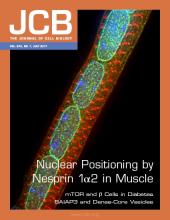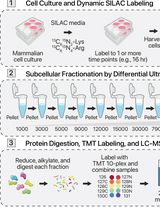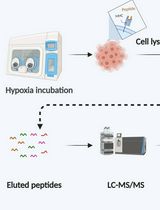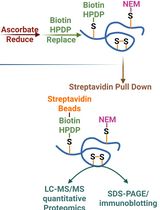- EN - English
- CN - 中文
High Throughput NPY-Venus and Serotonin Secretion Assays for Regulated Exocytosis in Neuroendocrine Cells
高通量NPY-Venus和5-羟色胺分泌实验分析神经内分泌细胞中被调控的胞吐作用
发布: 2018年01月05日第8卷第1期 DOI: 10.21769/BioProtoc.2680 浏览次数: 7407
评审: Ralph BottcherMelkam KebedeAnonymous reviewer(s)
Abstract
Here we describe two assays to measure dense core vesicle (DCV) exocytosis-mediated cargo secretion in neuroendocrine cells. To conduct siRNA screens for novel genes in regulated DCV exocytosis, we developed a plate reader-based secretion assay using DCV cargo, NPY-Venus, and an orthogonal 3H-serotonin secretion assay. The NPY-Venus secretion assay was successfully used for a high throughput siRNA screen, and the serotonin secretion assay was used to validate hits identified from the screen (Sorensen, 2017; Zhang et al., 2017).
Keywords: NPY (NPY)Background
Dense core vesicle (DCV) exocytosis mediates the secretion of proteins, peptides and small molecules from endocrine and neuroendocrine cells. Protein and peptide hormones enter the secretory pathway while they are being synthesized by ribosomes on the endoplasmic reticulum and sorted into DCVs at the trans-Golgi network (TGN) (Borgonovo et al., 2006; Bowman et al., 2009). Small molecules, such as serotonin, are directly taken up by vesicular monoamine transporters (VMATs) from the cytoplasm to the lumen of DCVs (Sudhof, 2004). Under non-stimulating conditions, cargo molecules are stored within DCVs in close proximity to the plasma membrane. When cells receive an external stimulation that increases cytoplasmic Ca2+, DCVs undergo regulated exocytosis and their contents are released to the outside of the cell (Klenchin and Martin, 2000). Released molecules control many critical biological processes, such as growth (Guerineau et al., 1998), ‘fight or flight’ response (Kishimoto et al., 2006), glucose metabolism (Lang, 1999), immune reactions (Griffiths et al., 2010), fertilization (Mayorga et al., 2007), etc. Due to the essential roles of regulated exocytosis, multiple electrophysiology- or microscopy-based methods have been developed to measure regulated exocytosis in live cells. Electrophysiological methods quantify regulated exocytosis by measuring either cell membrane capacitance or by amperometry to measure oxidizable secretory products (Martin, 2003; Zhang et al., 2011). Fluorescent microscopy-based methods measure regulated exocytosis by counting the number of fusion events at the plasma membrane by TIRF microscopy (Kabachinski et al., 2016). However, the above methods are difficult to apply to high throughput screening. Here, we developed a plate reader-based assay relying on NPY-Venus fluorescence. The assay utilizes genetically engineered BON cell lines that stably express a DCV cargo, NPY-Venus. When cells are stimulated with ionomycin in the presence of external Ca2+, intracellular Ca2+ concentration is rapidly increased and NPY-Venus is quickly released from DCVs by regulated exocytosis. The percent secretion of NPY-Venus is used as a measurement of regulated exocytosis. We have successfully optimized the assay for high throughput screens (Zhang et al., 2017). In addition, we described an orthogonal 3H-serotonin uptake and secretion assay that is similar to previous reports (Samuel Tran et al., 2004), which is also utilized to measure regulated DCV exocytosis (Zhang et al., 2017).
Materials and Reagents
- Pipette tips
- 1.7 ml microcentrifuge tubes (DOT Scientific, catalog number: 609-GMT )
- TPP 15 ml conical centrifuge tube (TPP Techno Plastic Products, catalog number: 91015 )
- 10 cm tissue culture dishes
- 96-well tissue culture plate (Corning, Costar®, catalog number: 3596 )
- 96-well black bottom assay plate (Corning, catalog number: 3915 )
- 0.2 μm syringe filter (Corning, catalog number: 431219 )
- NalgeneTM 0.45 μm cellulose acetate syringe filter (Thermo Fisher Scientific, catalog number: 190-2545 )
- Polycarbonate centrifuge tube (32 ml, Beckman Coulter, catalog number: 355631 )
- BON cells (a gift from C.M. Townsend, University of Texas Medical Branch, Galveston, TX)
Note: Maintain the BON cells in DMEM/F12 (1:1; Thermo Fisher Scientific, GibcoTM, catalog numbers: 11965092 and 11765062 ) supplemented with 10% FBS (PHENIX Research Products, catalog number: FBS-500US ) at 37 °C with 5% CO2). - HEK293FT cells (Thermo Fisher Scientific, InvitrogenTM, catalog number: R70007 )
- DMEM (Thermo Fisher Scientific, GibcoTM, catalog number: 11965092 )
- F12 nutrients (Thermo Fisher Scientific, GibcoTM, catalog number: 11765062 )
- Fetal bovine serum (PHENIX Research Products, catalog number: FBS-500US ; Thermo Fisher Scientific, catalog number: 16000044 )
- Metafectamine SI (Biontex Laboratories, catalog number: T100-1.0 )
- RNAiMAX (Thermo Fisher Scientific, catalog number: 13778030 )
- Potassium chloride (KCl) (Sigma-Aldrich, catalog number: P3911 )
- Potassium phosphate monobasic (KH2PO4) (Sigma-Aldrich, catalog number: P0662 )
- Sodium chloride (NaCl) (Sigma-Aldrich, catalog number: S9888 )
- Sodium bicarbonate (NaHCO3) (Sigma-Aldrich, catalog number: 792519 )
- Sodium phosphate dibasic (Na2HPO4) (Sigma-Aldrich, catalog number: S9763 )
- Sodium phosphate dibasic heptahydrate (Na2HPO4·7H2O) (Sigma-Aldrich, catalog number: S9390 )
- Trypsin-EDTA 0.25% (Thermo Fisher Scientific, GibcoTM, catalog number: 25200056 )
- NPY-Venus lenti construct pTM14-NPY-Venus (request from the Martin Lab)
- Opti-MEM medium (Thermo Fisher Scientific, catalog number: 31985070 )
- Calcium chloride (CaCl2) (Sigma-Aldrich, catalog number: 793639 )
- Magnesium chloride (MgCl2) (Sigma-Aldrich, catalog number: M9272 )
- HEPES (Sigma-Aldrich, catalog number: H3375 )
- Glucose (Sigma-Aldrich, catalog number: DX0145 )
- Ionomycin (Sigma-Aldrich, catalog number: I0634-5MG )
- DMSO (Sigma-Aldrich, catalog number: D8418-50ML )
- Hybri-MaxTM, cell culture grade DMSO (e.g., Sigma-Aldrich, catalog number: D2650 )
- Triton X-100 (Sigma-Aldrich, catalog number: T9284-1L )
- 3H-serotonin (PerkinElmer, catalog number: NET498001MC )
- L-ascorbic acid (Sigma-Aldrich, catalog number: A5960-25G )
- Envelop plasmid pMD2.G (Addgene, catalog number: 12259 )
- Packaging plasmid psPAX2 (Addgene, catalog number: 12260 )
- Protamine sulfate (Sigma-Aldrich, catalog number: P4020 )
- BON cell culture medium (see Recipes)
- HANK’s buffer(see Recipes)
- PSS-Na (see Recipes)
- L-ascorbic acid solution (see Recipes)
- HEK cell culture medium (see Recipes)
- Viral production medium (see Recipes)
- HBeS (2x) (see Recipes)
- CaCl2 solution (see Recipes)
- Protamine sulfate (see Recipes)
- BON cell freezing medium (see Recipes)
Equipment
- Tissue culture incubator
- Multichannel pipettes
- Automated liquid handling system (Biotek Microflo dispenser, Thermo Scientific Matrix Hydra DT 96-well liquid handler, optional)
- Tecan plate reader (Infinite F500 with excitation filter 485/20 and emission filter 535/25 or Safire II with excitation 505/20 and emission 535/10) (Tecan Trading, model: Infinite® F500 )
- Beckman ultracentrifuge with a Ti70 rotor
- Ti70 rotor (Beckman Coulter, model: Type 70 Ti )
- Multichannel aspirator (Argos Technologies, catalog number: EV503 )
- FACS sorter (BD, model: FACSAriaTM II )
- Fluorescent microscopy with FITC excitation and emission filters
- Scintillator counter
Procedure
文章信息
版权信息
© 2018 The Authors; exclusive licensee Bio-protocol LLC.
如何引用
Readers should cite both the Bio-protocol article and the original research article where this protocol was used:
- Zhang, X. and Martin, T. F. (2018). High Throughput NPY-Venus and Serotonin Secretion Assays for Regulated Exocytosis in Neuroendocrine Cells. Bio-protocol 8(1): e2680. DOI: 10.21769/BioProtoc.2680.
- Zhang, X., Jiang, S., Mitok, K. A., Li, L., Attie, A. D. and Martin, T. F. J. (2017). BAIAP3, a C2 domain-containing Munc13 protein, controls the fate of dense-core vesicles in neuroendocrine cells. J Cell Biol 216(7): 2151-2166.
分类
细胞生物学 > 基于细胞的分析方法 > 蛋白质分泌
生物化学 > 蛋白质 > 定量
您对这篇实验方法有问题吗?
在此处发布您的问题,我们将邀请本文作者来回答。同时,我们会将您的问题发布到Bio-protocol Exchange,以便寻求社区成员的帮助。
Share
Bluesky
X
Copy link












